50 creative sports photography ideas for your next photoshoot.
Sports photography is a dynamic genre of photography that involves documenting the different activities at sports events, including fan reactions, players’ movements, VIP and stakeholders’ presence. It is also a form of storytelling to ensure specific sports highlights are preserved for posterity’s sake.
Furthermore, sports photography isn’t scripted and often doesn’t allow retakes since actions are live. Thus, as a sports photographer, you need more than just skill and equipment to make the most of your sports photography shoots. You need to always be wearing your creative hat, leverage unique perspectives, and be ready to click the shutter at the right moment.
In this article, we explore 50 creative sports photography ideas to spur you. But before we dive into them, let’s look at some diverse sports genres and events high-volume photographers can specialize in.
14-day free trial. No credit card required.
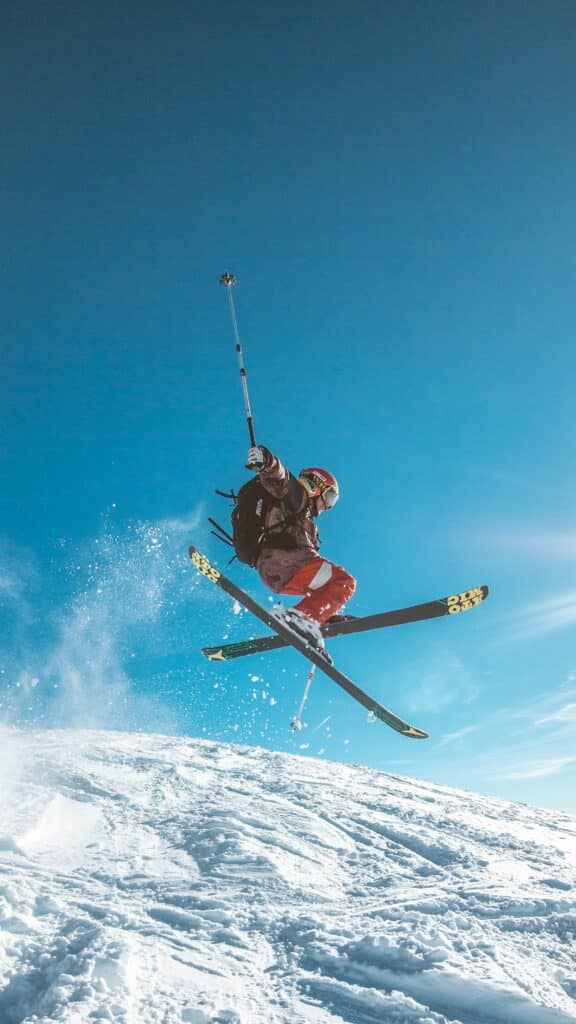
Sports genres and events for high-volume photographers.
From local parks to recreation centers to professional competitions, high-volume photographers can shoot at different sports levels or events, such as:
- Team sports: Football, soccer, baseball, basketball, rugby, volleyball, cheerleading competitions, and high-school sports.
- Individual sports: Gymnastics, cycling, golf, and track and field events.
- Motorsports: Car and bike racing.
- Water sports: Swimming, diving, wave pool surfing, and rowing.
- Combat or strength sports: Martial arts, wrestling, boxing, weightlifting, and bodybuilding.
- Equestrian sports: Horse shows, gymkhana, rodeo, and dressage competitions.
Live-action sports photography ideas.
Here are some captivating photo ideas to try when you’re at a live-action sports event:
1. Players performing an action
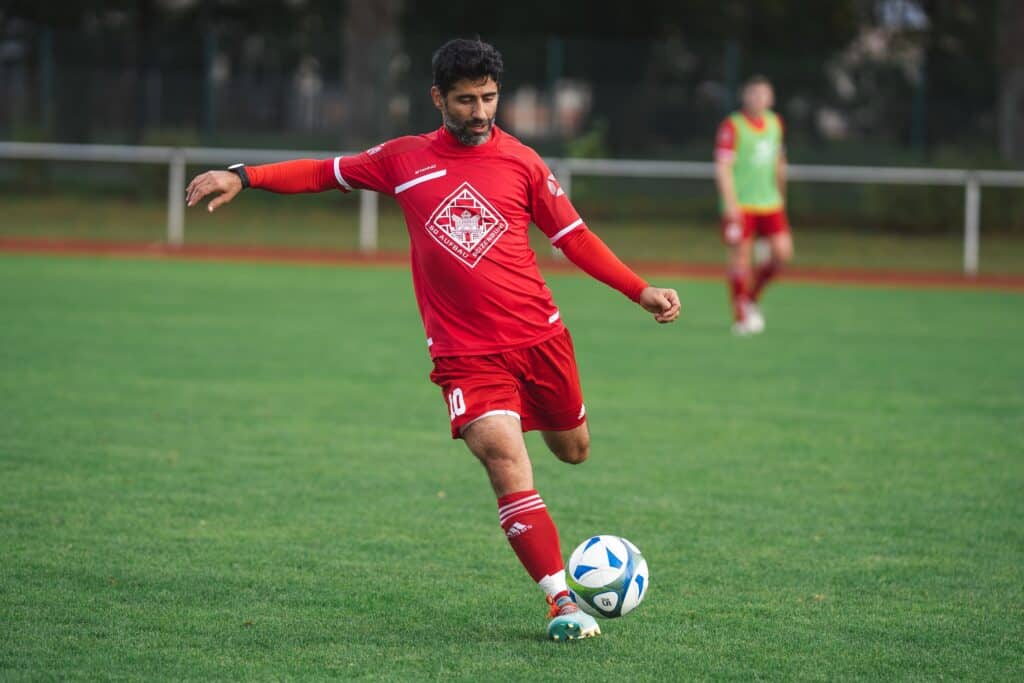
Sport is synonymous with action. And the best way to depict this is to capture a player taking action during a live sports event. For example, you can take a photo of a footballer kicking a ball or a volleyball player making a serve.
Get a suitable position in the sports area and capture as many actions as possible. You can also experiment with panning shots to highlight speed and motion. If possible, leave the stands and head to the sidelines. That will help you stay closer to the action.
2. Facial expressions of players.
Part of your live-action sports photography goals should include featuring players’ facial expressions, whether it is of joy, sadness, or fatigue. It is common to capture players running around the game area. Taking action shots with sweat dripping off them or smirks on their faces is a great way to show the emotions behind the game.
Get to ground level and take pictures from all sides of the field, zooming in on their faces to add a sense of detail and intensity. Also, pay close attention to participants and their visual cues to enable you to predict their reactions after an action.
3. Referees’ actions
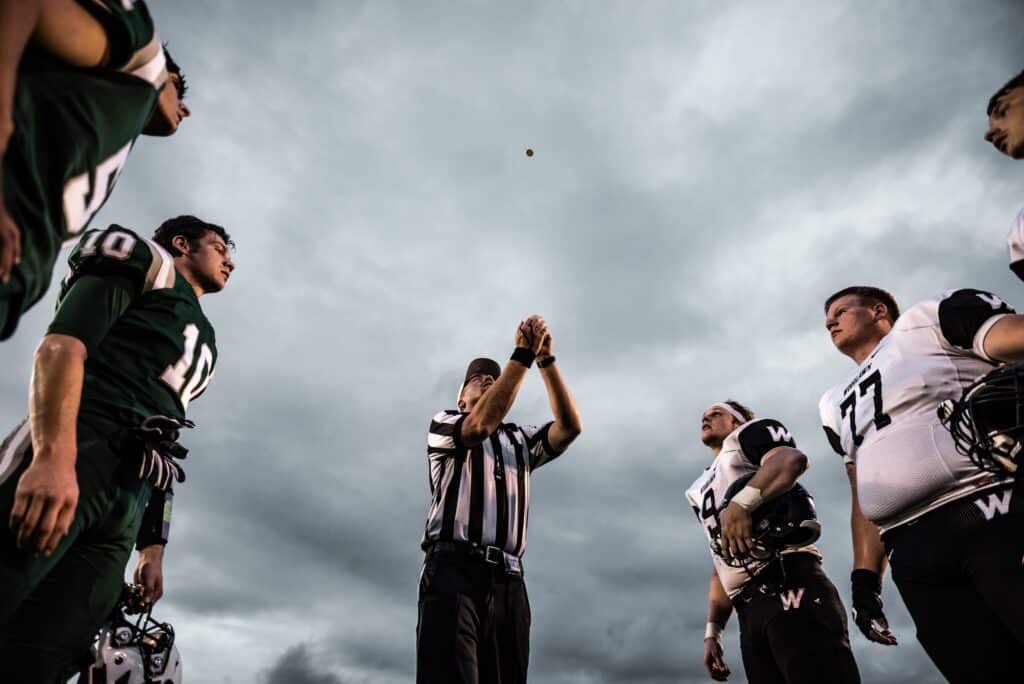
In sports events like soccer, referees are important officials responsible for a lot of activities that go on in the game area. Hence, their actions and facial expressions are worth capturing. Intermittently take shots of the referee in action from the first whistle, signifying the start of the live game, to the final whistle, indicating the end.
4. Objects in motion
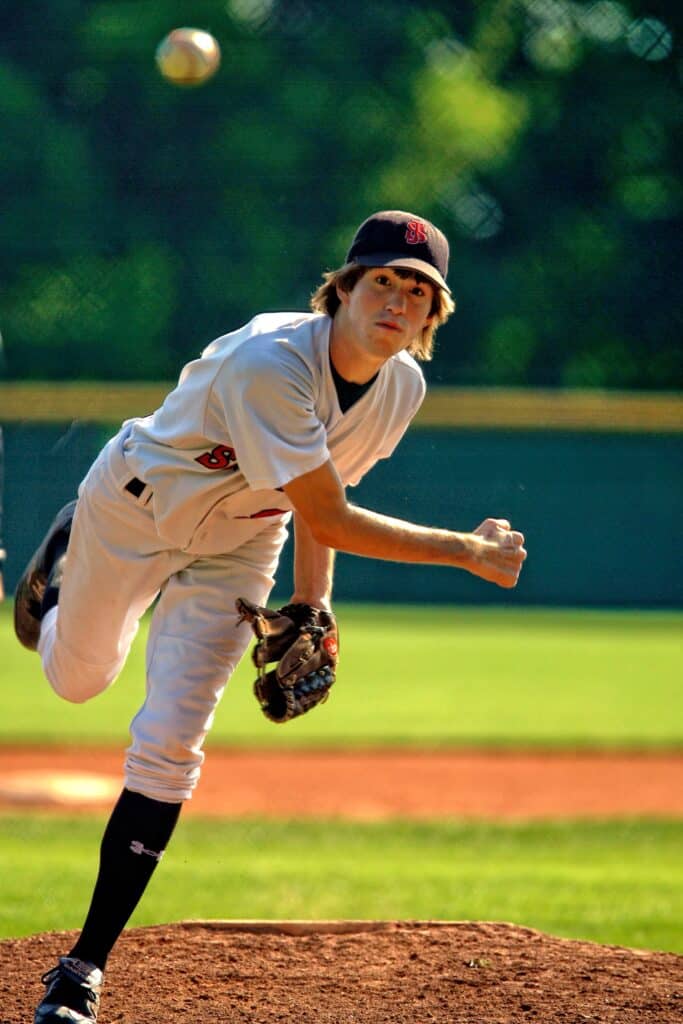
Capturing the object of play in motion is an interesting way to add vitality to your shots. For example, in a sports event like football, you can photograph a soccer ball mid-air when players toss it around.
Fortunately, you can take such images from any angle, revealing the beauty in the ordinary.
5. Off-field or pitch shots
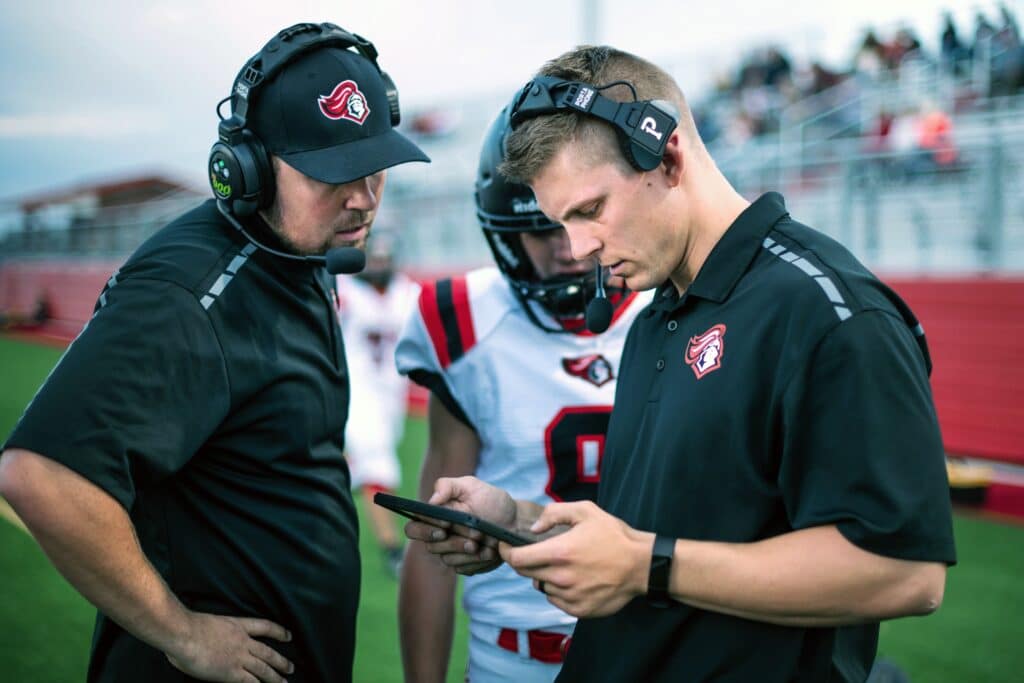
Not all live actions happen on the field; a lot happens on the sidelines, off-field. So, consider turning your camera in that direction. You can capture the head coach yelling at players, the apprehensive look on other players waiting to get into the fray, or other sports officials doing one thing or the other.
6. Look into the crowd
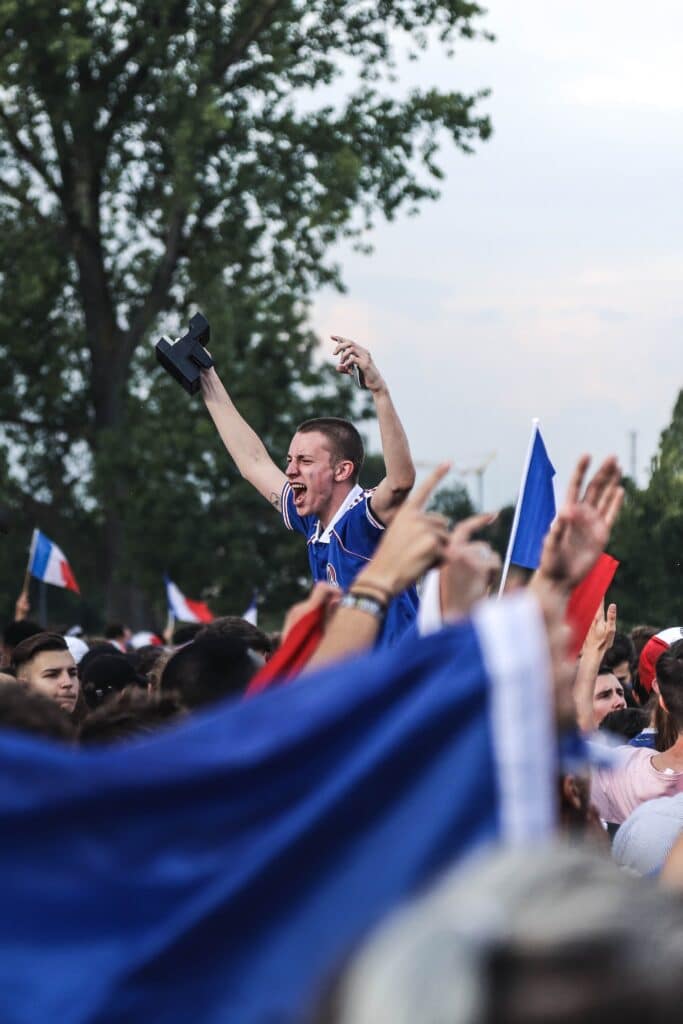
Besides focusing on participants, photographing spectators will help you convey the overall energy for the day. Pay attention to what’s happening in the stands before, during, and after the game.
Which team has the most standout characters in the crowd? Which team is leading the chants? Whatever the case, photographing the audience at scale can provide depth and context to your sports photography sessions.
Youth, high school, and college sports photography ideas.
In high school and college sports photography, you’re mostly faced with creating memories for the school, students, and their guardians or parents. Below are some ideas to get you started:
1. Behind the scenes
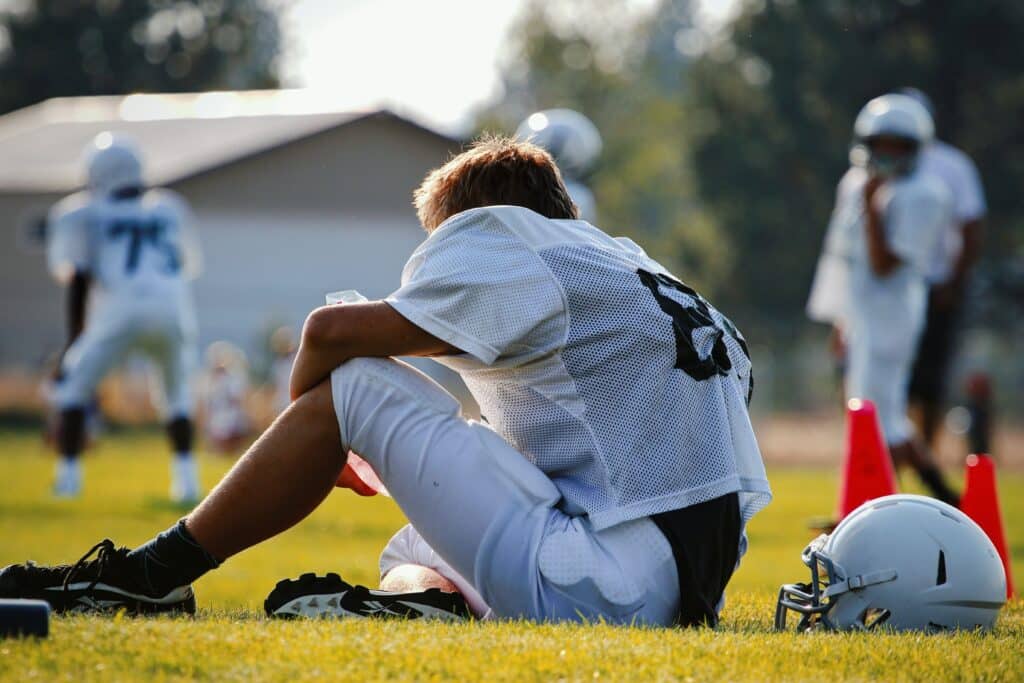
Documenting students’ activities before the game can provide a glimpse into the dedication and hard work that goes into their performance. So, try capturing them dressing or tidying up in their locker room before the game commences.
2. Capture the sports area
Photograph the sports arena or grandstand filled with parents, guardians, and other students. You can use the first break as your opportunity. That allows you to capture the crowd without missing other important game highlights.
3. Players at their ideal location
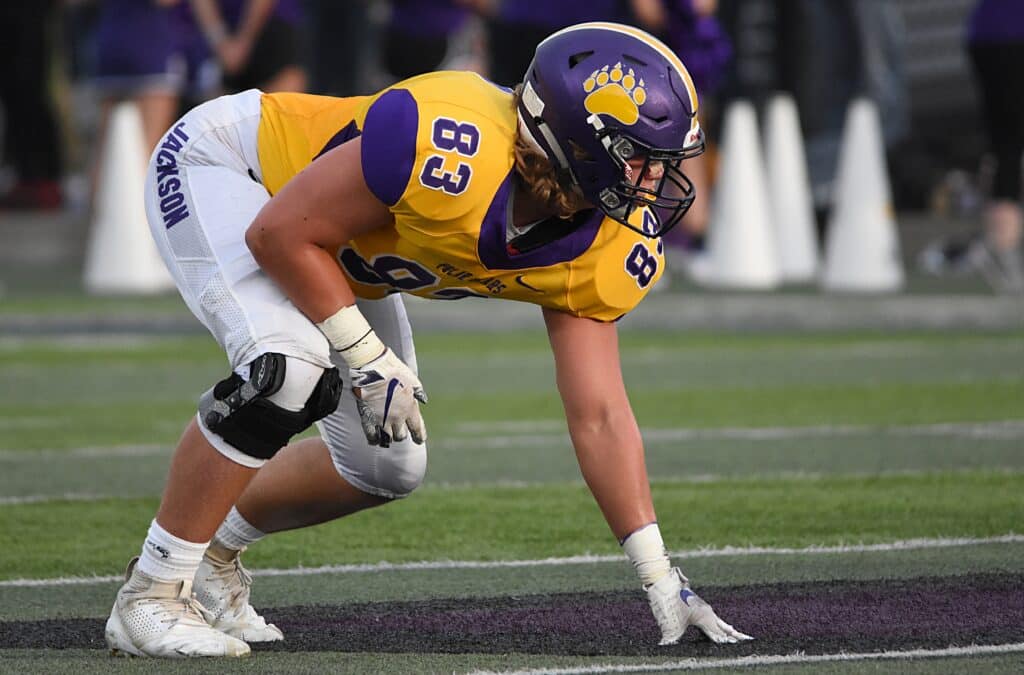
Capture players in their natural sporting environment, such as a basketball player on a city court, or a track runner on the starting blocks. These shots can add context and a sense of place to the images.
4. Close-up details of the sport
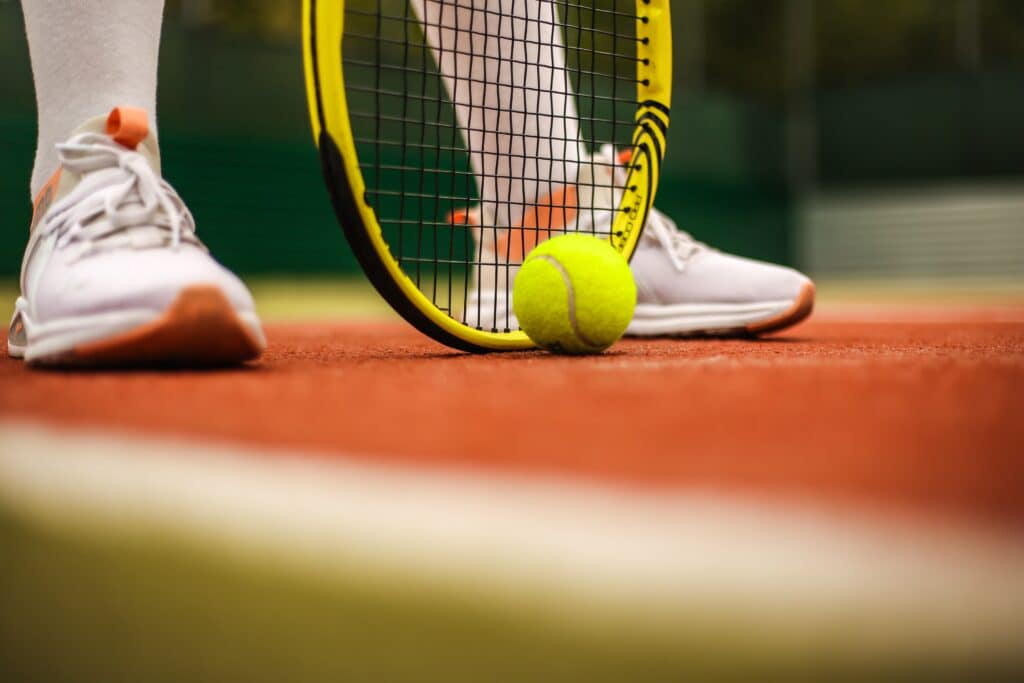
Take close-up shots of specific details that can explain the sport without the need for an explainer. For example, capturing a basketball hoop shows that it is a basketball game, while the mud-covered cleats of a soccer player show that it is a soccer game.
5. Pre-game routines
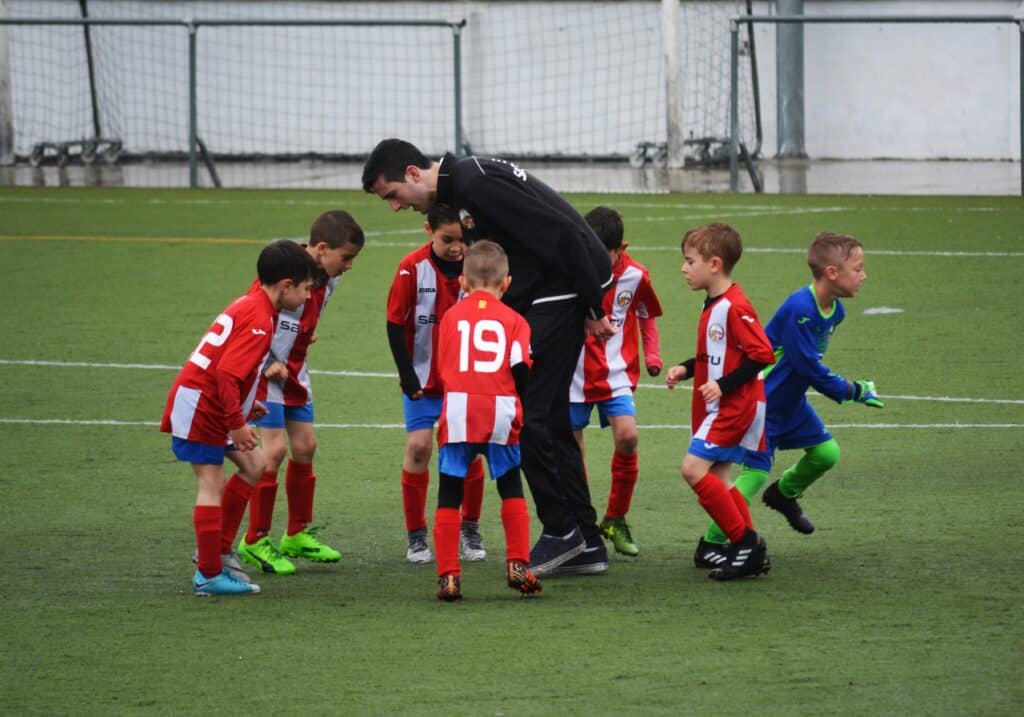
Moments leading up to the game are interesting little windows with many emotions. Hence, taking some shots before the game begins properly would be nice. You can capture a team’s pre-game rituals—such as them singing the national anthem, conversing, praying, or warming up.
This photography idea showcases team spirit, anticipation, and enthusiasm for the game. Additionally, to successfully bring this photography idea to life, you must be at the sports venue early to get a full view of each team’s pre-game routines.
Equine event photography ideas
As a sports photographer looking to explore equine photography, practicing with these ideas below will help you make a smooth entry into the industry while earning some bucks too.
1. Horse and rider
Capturing a horse and its rider is a great way to commemorate their relationship or showcase candid moments. To replicate this idea, have the rider stand beside the horse, sit on it, hug it passionately, or hold it by the reins. Moreover, you can take portrait shots of the horse and rider before or after the competition.
2. Horse-only portraits
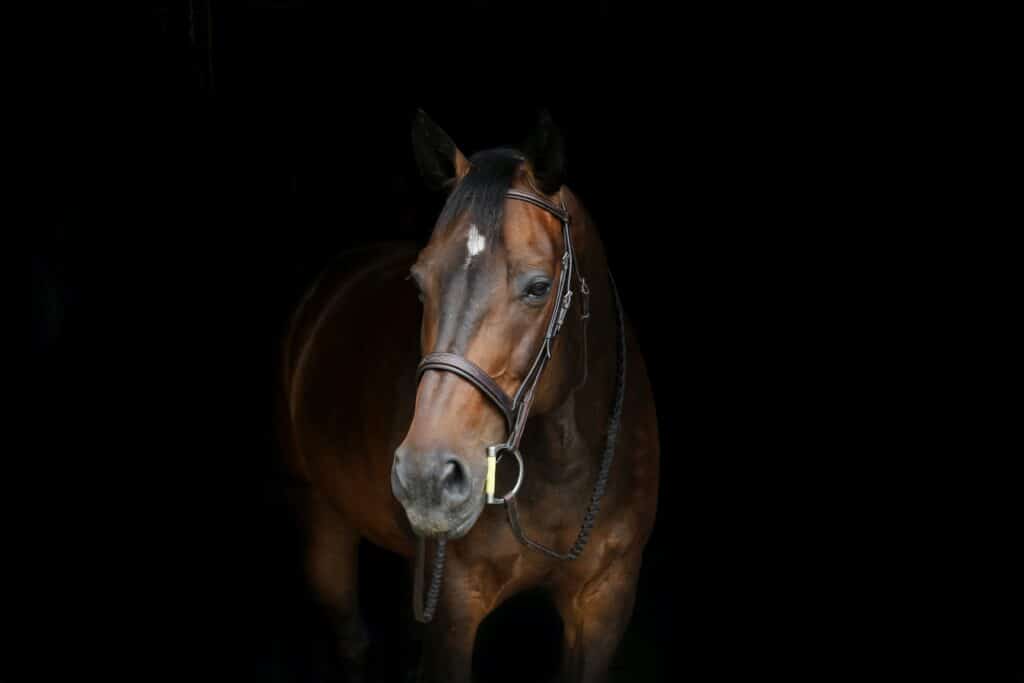
Shooting horse-only portraits is a common way to show off the beautiful facial details of horses—such as markings, labels, or scars—in a horse show or dressage competition. You can show the natural background (the paddock area) to elevate the look or dim the background to create a dark effect.
However, endeavor to set your camera to portrait mode to enable you to highlight the horse’s face and blur the background. Be sure to get permission from its owner or equestrian handler for safety purposes and have them position the horse for better shots.
3. Horse and rider action shots
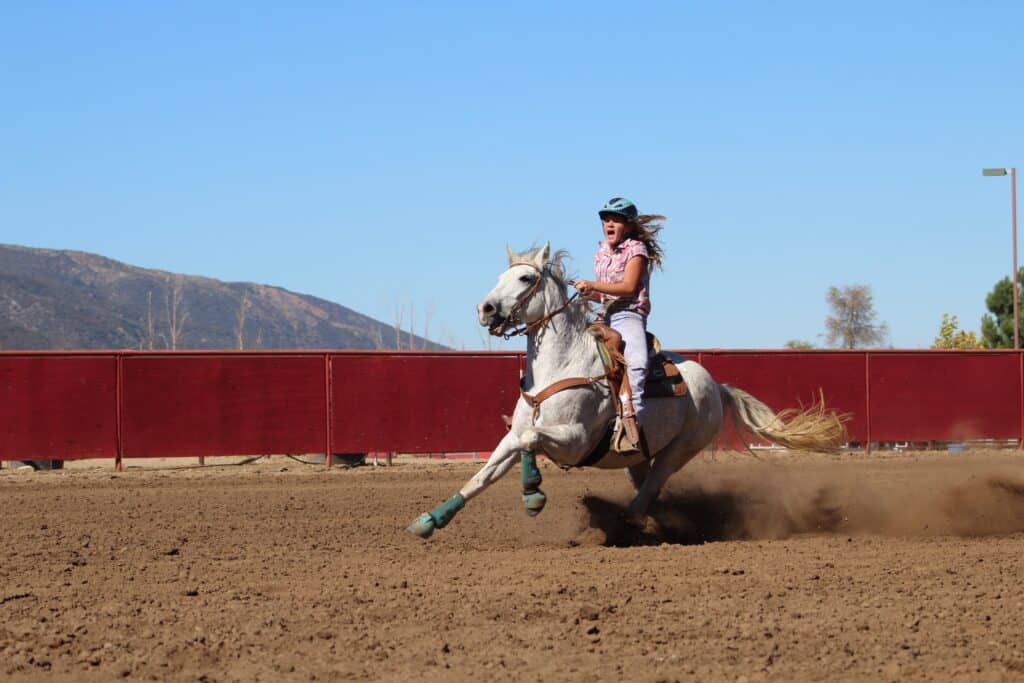
Taking equine photos in motion is tricky, especially since you have no control over the horses’ movements and need to reveal their elegance in action. You can photograph a rider holding still and ready to gallop with their horse or the horse whirling about with the rider on top.
You can also take photos of the horse jumping or doing an extended trot. Shots like these display the strength of the horse and the harmony between it and the rider while in motion. Thankfully, you can take it from any angle that makes the action more vivid.
4. Close-up detail shots of horses’ bodies
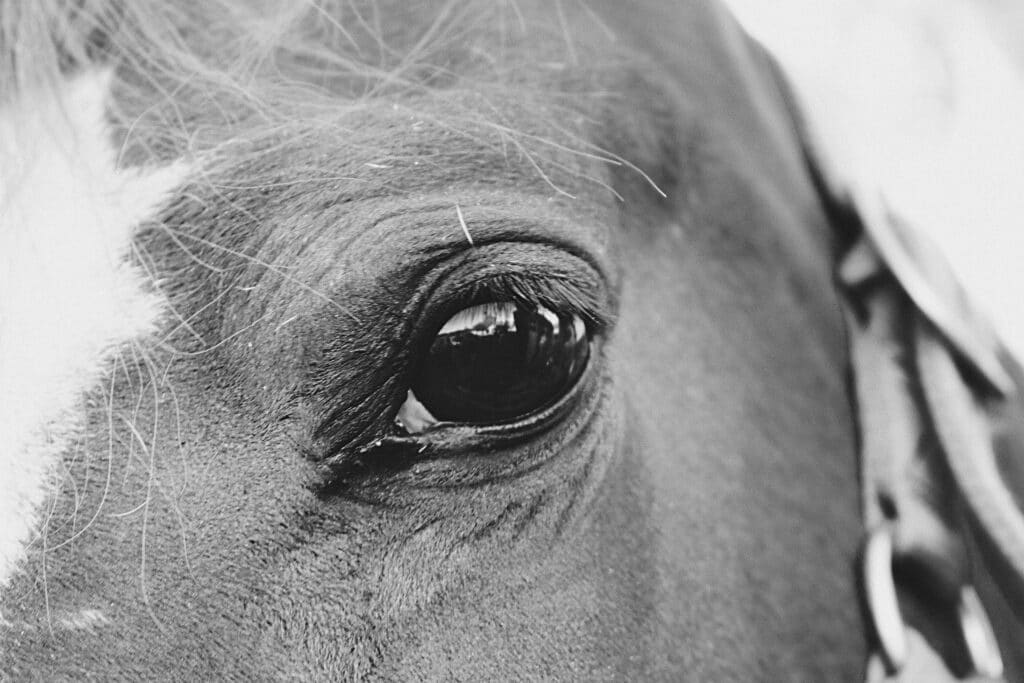
Horses are living wonders, and capturing specific details of their body is magical. You can photograph their hooves, ears, tail, mane, eyes, or muzzles.
Moreover, at a horse show or dressage competition, you can photograph numerous details of different horses while at rest or in motion. Photos like that explain the uniqueness of each horse at a glance.
5. Equipment and other add-ons
Taking photos of the equipment, rider’s attire, and tack details like boots, saddle pads, stirrups, and browband is another equine photography idea you should try. You can do this before or after the competition.
Dance competition photography ideas
The ideas below will sprout your creativity and help you portray the beauty of dance art at dance competitions through your camera lens.
1. Action shots at a high point of movement
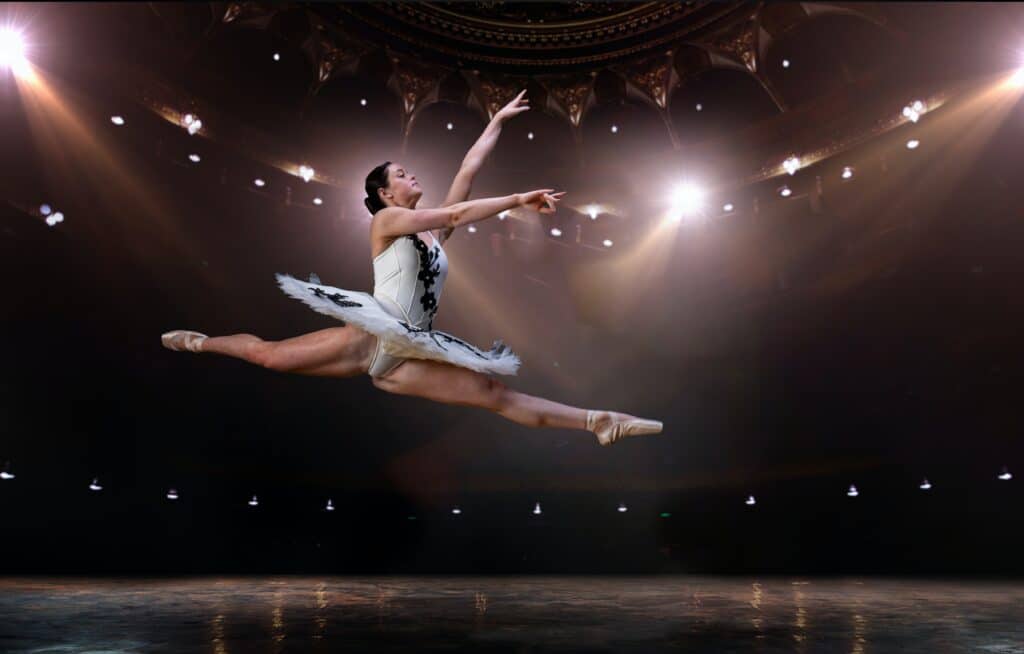
Consider capturing a dancer at the highest point of movement or jump. This will allow you to achieve the most dramatic effect, seeing that the body will be suspended in the air at some point.
To get the perfect shots, move around the dance theater or venue, trying different angles and taking as many shots as possible. Additionally, leverage available lighting effects during the performances—such as spotlights or colored gels—to enhance the visual impact of your images.
2. Inanimate dance props
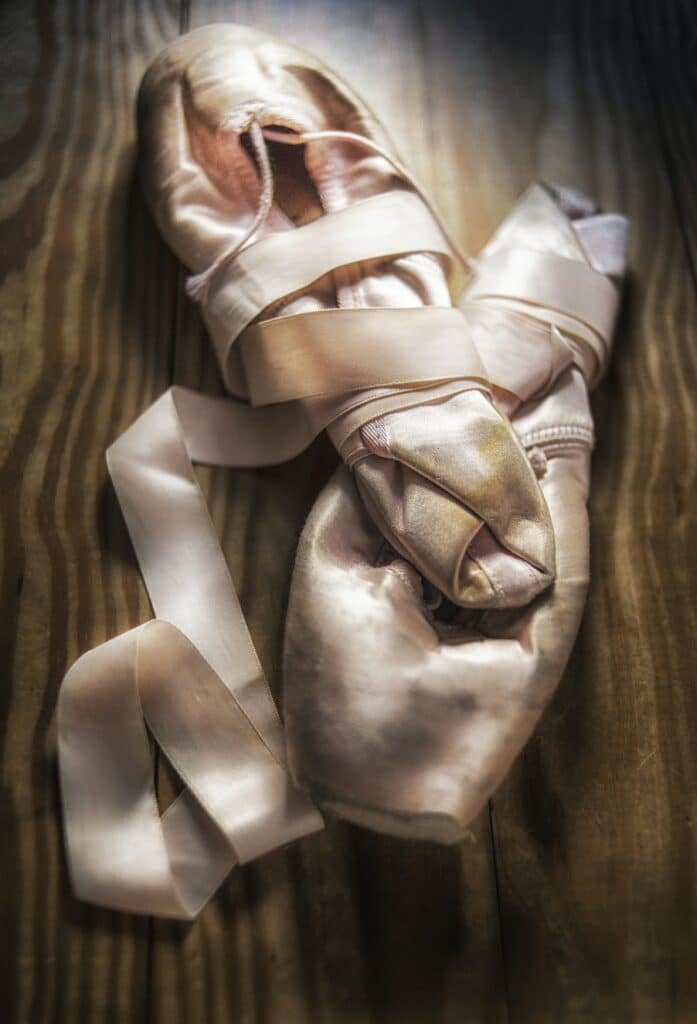
Don’t be limited to only capturing dance in action. You can create a whole story by photographing inanimate dance props, providing context to your photos. You can take numerous shots of ballet shoes, gloves, ribbons, and scarves.
Furthermore, you can freeze the props mid-air while in motion or use long-exposure techniques to create dynamic images. You can also zoom in on dancers’ costumes to capture the texture, colors, design, and embellishments.
3. Capture different body parts up close
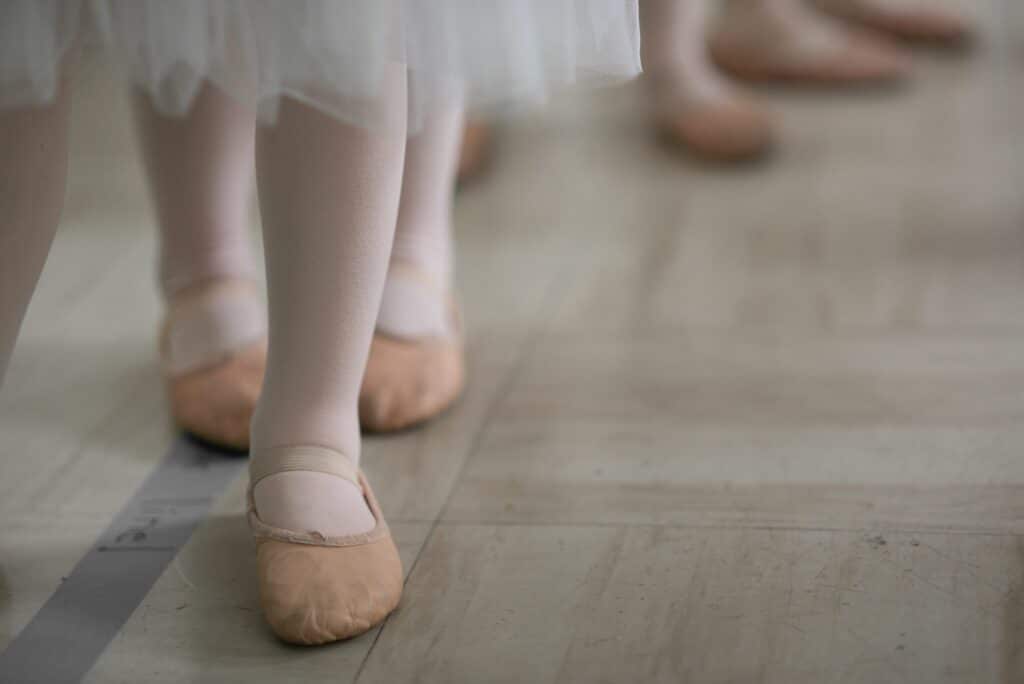
Consider taking shots that flatter other body parts, such as the hands, fingers, and toes, as they make graceful movements. For example, in ballet or other contemporary dance styles, you can capture a dancer’s pointed feet (toes), highlighting the arches and alignment of their ankles. Such images allow viewers to appreciate dancers’ strength and their fluidity.
4. Focus on facial expressions
Beyond making movements according to the rhythm and tempo of a sound, dancers tell stories through their facial expressions. One way to portray the depth of their performances is by taking close-up shots of their facial expressions before, during, and after the dance session.
You can photograph both individual and group dancers at intervals. Look out for subtle cues every step of the way. Doing so lets you predict their expressions and be ready to click the shutter accordingly.
5. Group shots
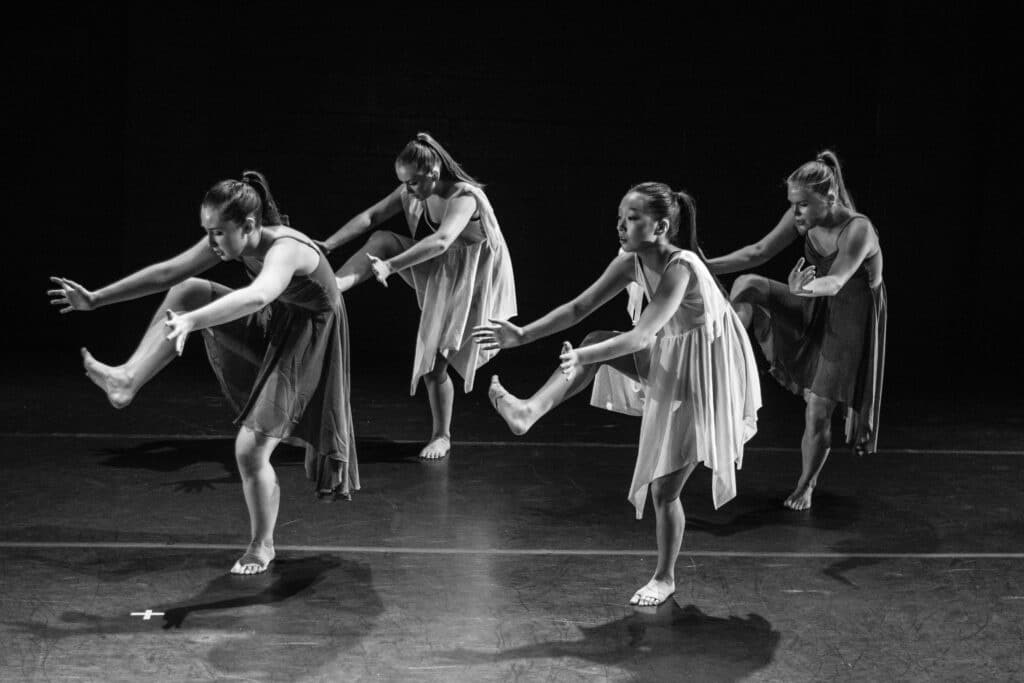
Consider capturing group dancers when they make visually appealing formations and intricate patterns during their performance. You can also capture moments of support or celebration (mainly after their performance).
Such images show coordination, camaraderie, and teamwork within the group and dance community.
6. Backstage shots
Sometimes, telling stories through photography requires you to document all activities from start to finish. So, try photographing moments before dancers take the stage.
Focus on their interactions and emotions as they prepare for their performance. These candid shots can provide a unique behind-the-scenes perspective of the dance competition.
Cheer competition photography ideas
Here are unique ideas that will help you get the best shots at any cheerleading event or competition you attend.
1. Action shots
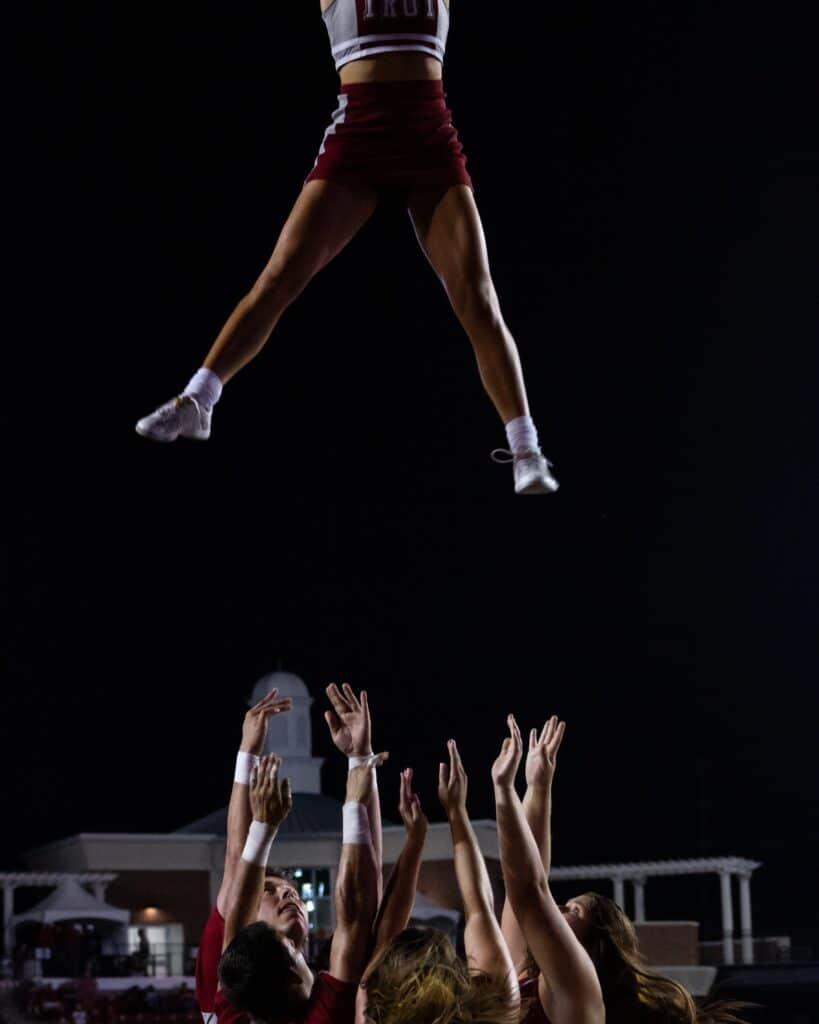
Highlight cheerleaders being lifted or tossed in the air, capturing high-flying flips, stunts, and other unusual maneuvers. Try freezing the moment when they are at the peak of their performance for better visual impact.
With this idea, you can show cheerleaders’ athleticism, energy, and team spirit. Moreover, you can play around with motion blur for more dramatic effects.
2. Synchronized routines
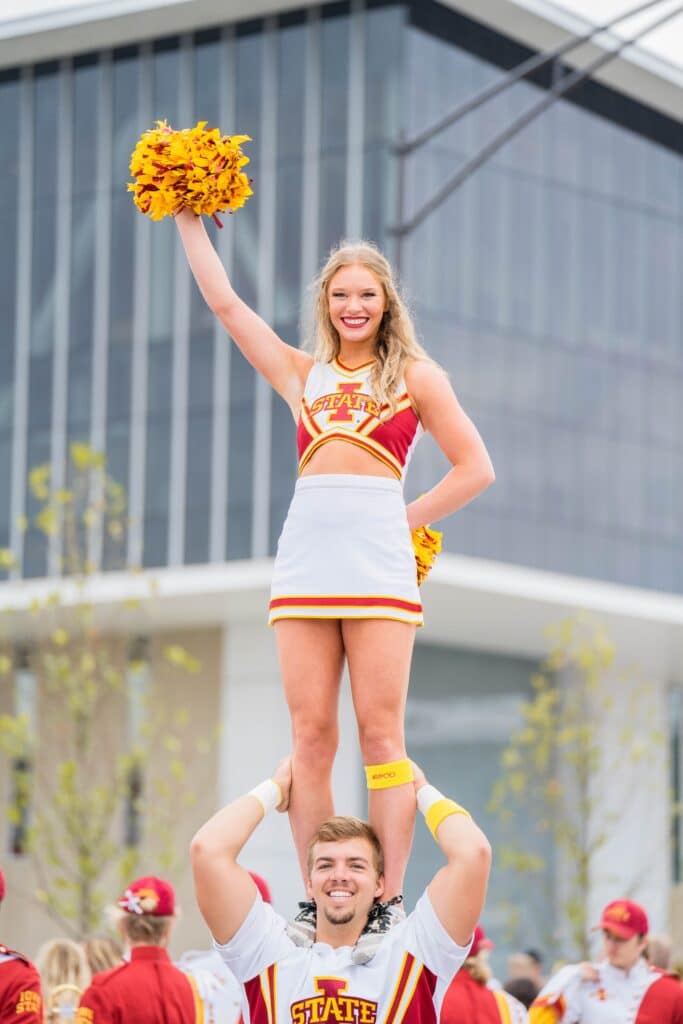
Take photos of cheerleaders when they take distinctive forms, such as a spiral or pyramid. Capture the formations from different angles, highlighting the precision and harmony in their movements.
To successfully pull this idea off, pay close attention throughout their performances to capture all the blink-and-you-miss-it moments.
3. Show emotions
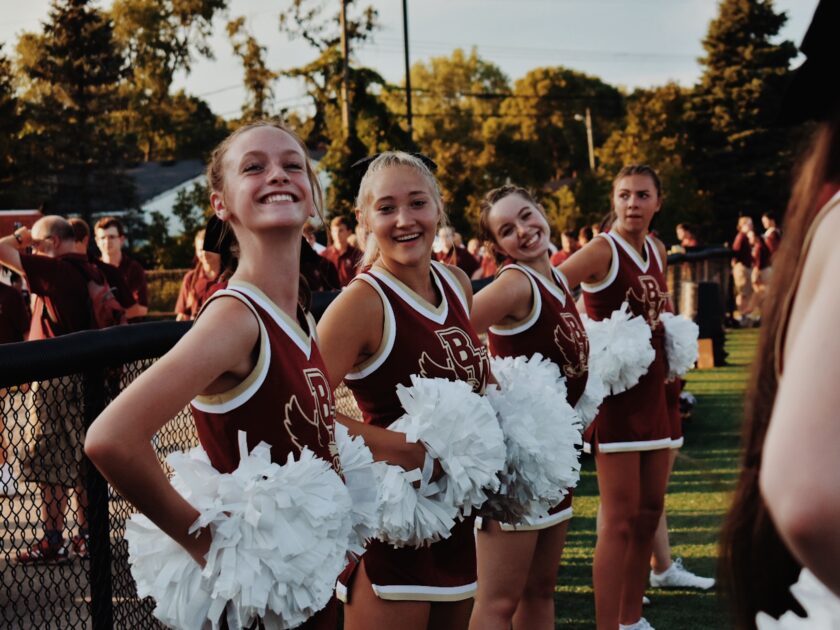
Photograph cheerleaders’ facial expressions and emotions, showcasing their determination, excitement, and passion for the game. You can take such shots at any time of the competition.
In addition, you can capture the expressions of supporters, bleachers, and stakeholders on the sidelines to enable viewers to deduce the overall emotions behind the game at different times.
4. Cheerleading props
Photographing props is a great way to add fun and variety to your cheerleading photos. Zoom in to capture props like pom-poms, shoes, ribbons, or uniforms. You can take these shots backstage while cheerleaders prepare or during live actions.
Motorsports photography ideas
Motorsport is invariably a fast-paced, adrenaline sport. Nonetheless, these ideas below will help you portray its beauty in the best possible shots.
1. Waiting to zoom off
Waiting moments are filled with anticipation and preparation, and capturing them adds interesting dimensions to your motorsports photography.
Take shots of motor vehicles lined up in the starting grid before the race begins and during pit stops. Try shooting from various angles—elevated positions from the ground or through the barriers.
2. Off-track and overview shots
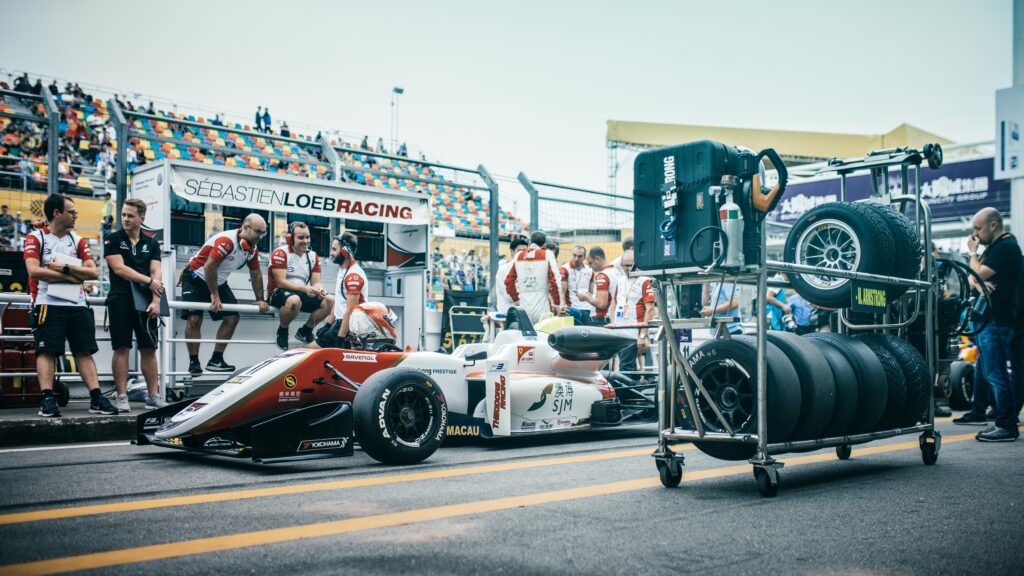
Car competitions are not about cars only. Take your camera off the track and capture the audience that brings the spice to such events. You can also use a wide-angle lens to capture the entire scene, emphasizing the scale of the event.
Such images should include the track (with automobiles in motion or at rest), spectators, officials, the podium, and every nuance of the venue. Move around the competition area for better view and context, and get as many quality photos as possible. As always, prioritize your safety as you do so.
3. Live action shots
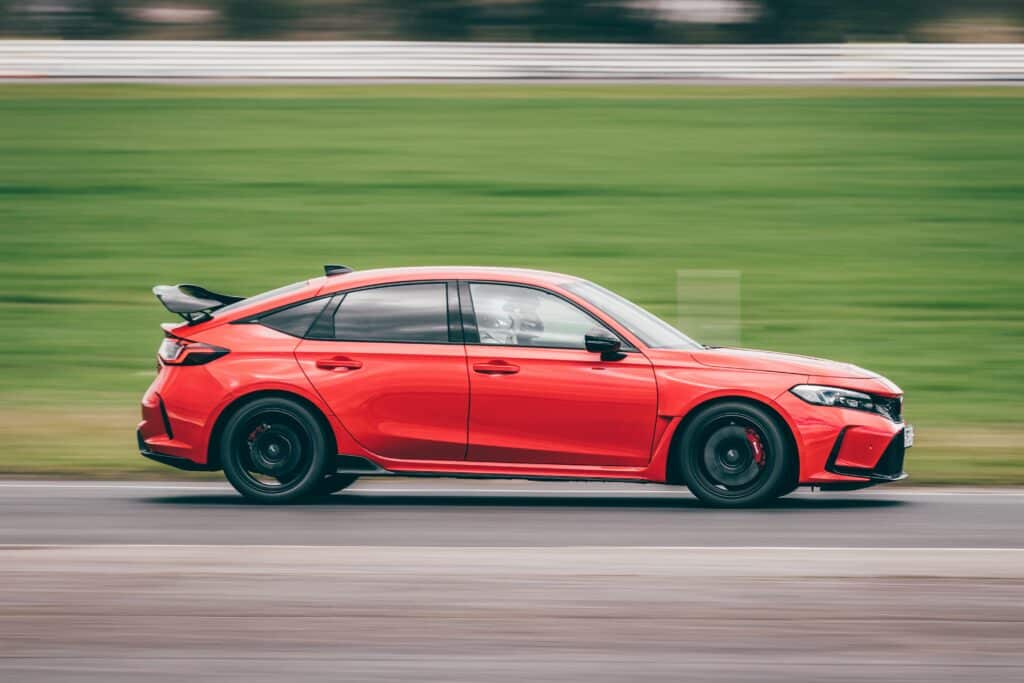
Your motorsports photography session is incomplete without action shots that evoke emotions. Position your camera in the same direction as the motor vehicles in motion, leveraging slow shutter speeds and dynamic angles.
Fortunately, you can combine panning techniques and motion blur to get surreal images that convey a sense of speed and movement. You can also take a sequence of shots to show the progression of the competition.
4. Action freeze
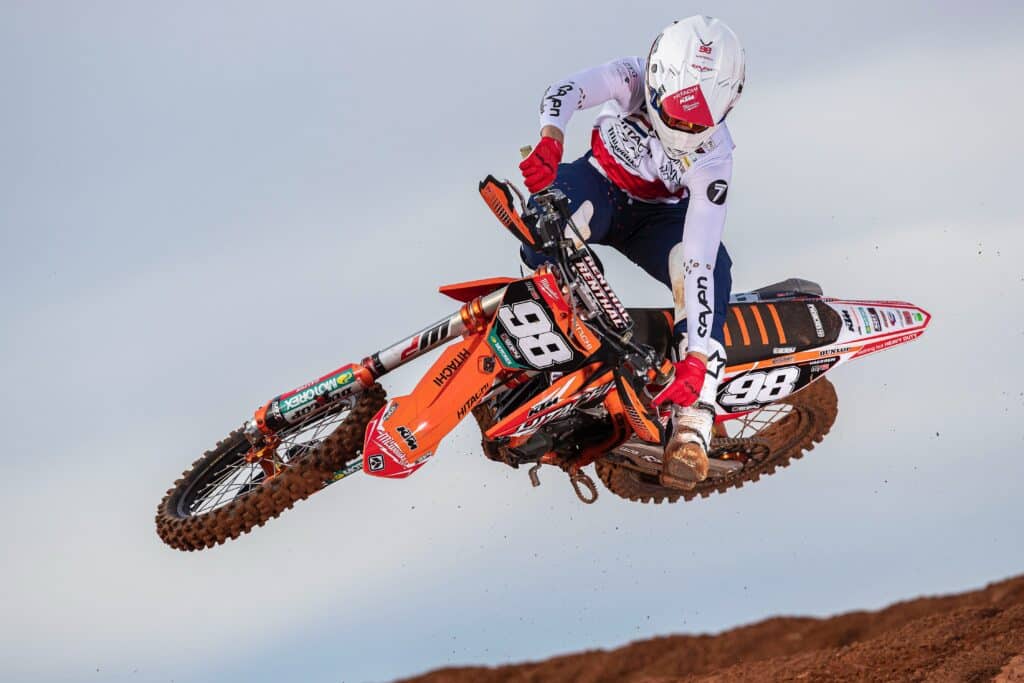
Besides panning techniques, you can use a fast shutter speed to halt actions. This lets you capture thrilling split-second moments like a car or bike mid-air during a jump or high-fly.
5. Close-up details of drivers
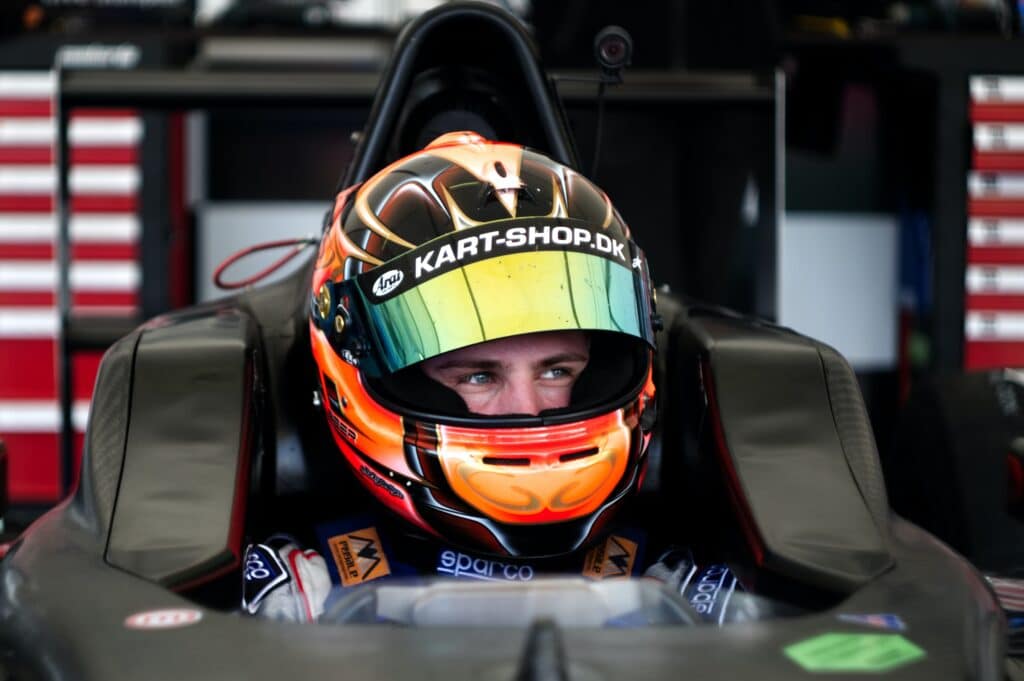
This idea may seem difficult to create because of the distance between the track and the sidelines. However, with a few tricks and turns, you’ll be able to get a close-up image of the drivers.
Use telephoto lenses to zoom in on their faces or hands on the wheel. Focus on taking shots that depict distinct emotions, such as excitement and determination. You can also capture drivers during pre- and post-race interviews, providing different perspectives to the competition.
6. Close-up details of race elements
Capturing specific elements of the race—such as tire treads, drivers’ helmets, contest banners, and flags—enables you to provide viewers with intricate details of the competition that often go unnoticed.
The tire treads can show the intensity of the live actions, while helmets or racing suits can reveal drivers’ personalities and team affiliations. On the other hand, contest banners and flags can showcase event sponsors and important info for the audience.
7. Show audiences’ emotions and reactions
Capture the emotions and reactions of pit crews and spectators every step of the way. Whether it is the excitement from a win or disappointment from a setback, highlighting audiences’ emotions adds depth and storytelling to your motorsports photography.
Dog show photography ideas
Dog show photography can be challenging, but utilizing the ideas below can enable you to churn out timeless images.
1. Action shots
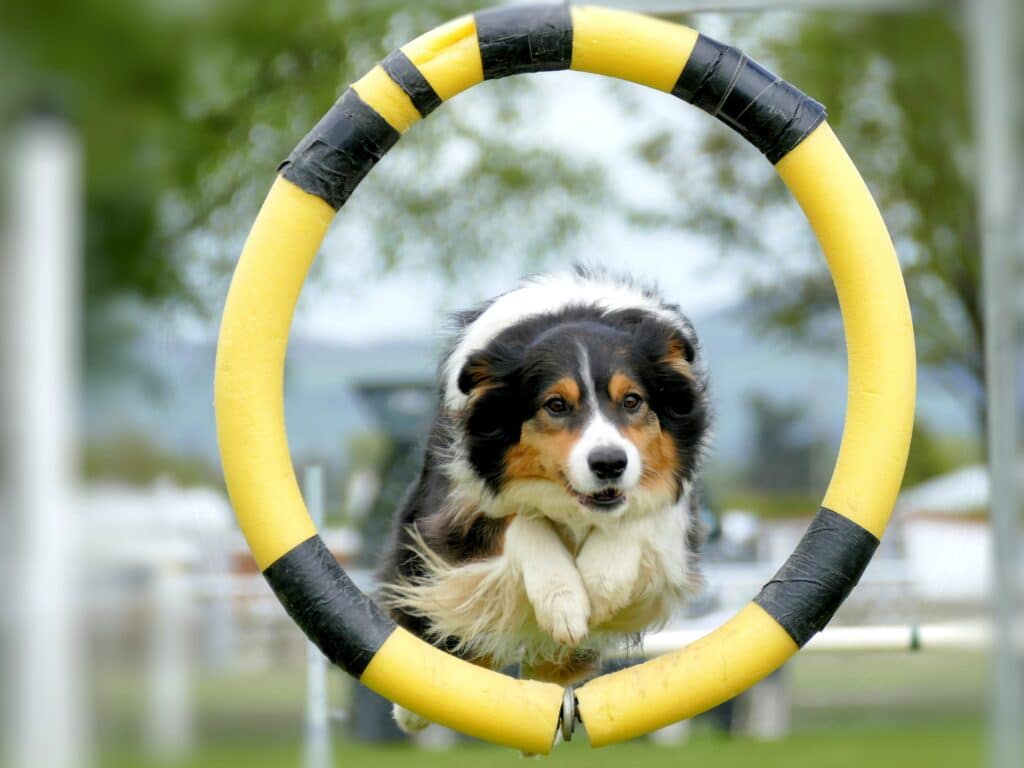
Capture dogs in motion, showcasing their agility and gracefulness as they trot, jump, or perform tricks. You can use a fast shutter speed to create a freezing effect, suspending them in the air amidst movements.
Likewise, you can play with different angles and perspectives, such as shooting down from the dog’s level or an elevated position.
2. Dog and owner moments
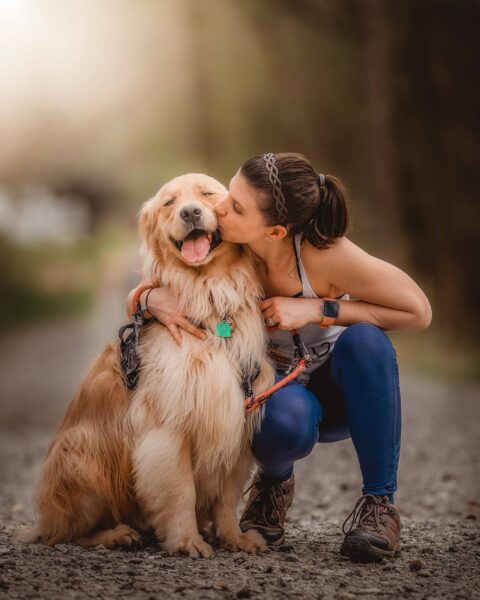
Photograph dogs and their owners before, during, or after the show. This enables you to showcase their bond and emotions at different event times. To pull this off, have the owner sit or stand beside or snuggle their dog while you take as many shots as possible.
3. Highlight expressions
Focus on capturing dogs’ facial and body language expressions at every point in the competition. It helps you evoke their dispositions for the show, whether it is excitement, preparedness, or reluctance.
4. Pre-show moments
Document different dogs’ grooming processes before the show, highlighting the meticulous care they receive ahead of the event. Also, capture the trainers, handlers, and judges preparing for the show to portray the professionalism involved in dog shows.
5. Standalone full-body dog shots
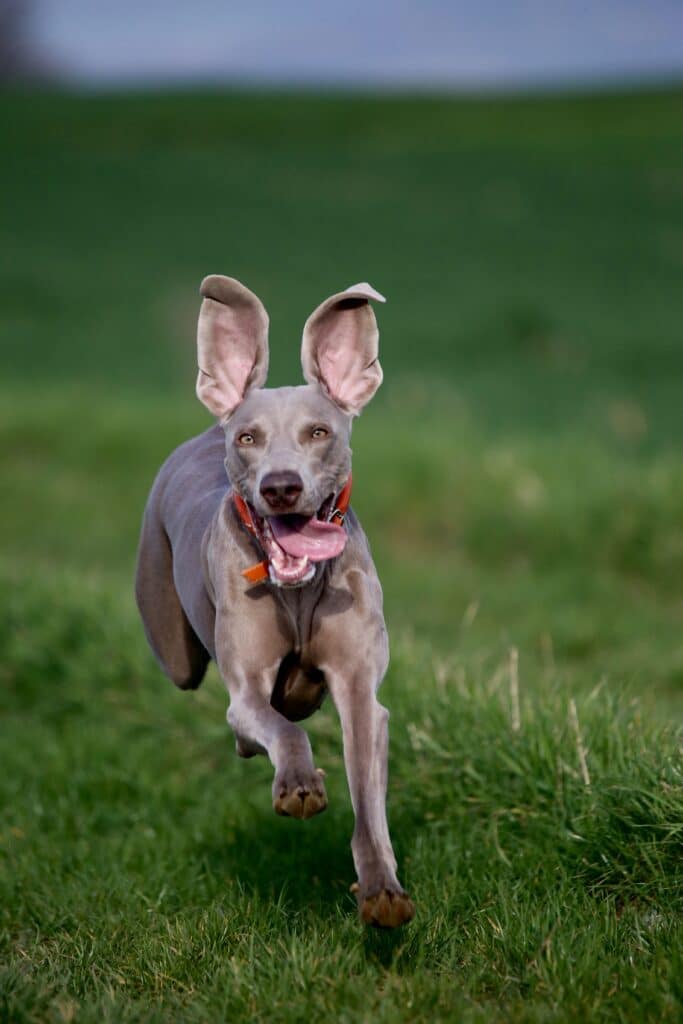
Standalone shots highlight the distinct features of each dog, including their colors, sizes, paws, tails, and other physical attributes. It could be up-close shots or from any angle.
The primary goal of this idea is to showcase the different breeds participating in the show. Moreover, you can play with shallow depth of field to blur the background and place focus on the dogs.
6. Away from the dogs
Randomly capture candid moments outside the ring or show area, such as the expressions and reactions of the audience before, during, and after the show. Images like this depict the emotional rollercoaster of the competition.
7. Focus on the face explicitly
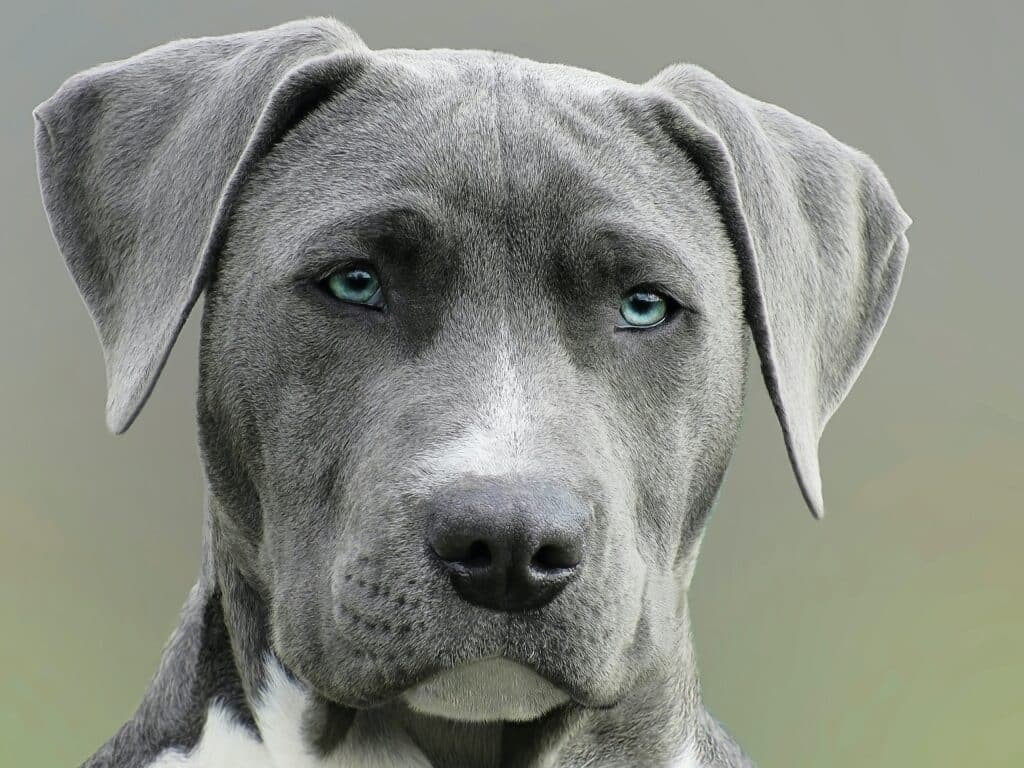
A headshot displaying the entirety of a dog’s face should be a staple in your dog show photography collection. Hence, try to capture every detail on their faces, especially the eyes that convey many emotions.
Such images can evoke feelings in viewers and help them deduce each dog’s personality. To get nice photos, go close to the lineup (with permission) and position yourself so you can see their faces straight on.
Otherwise, you may wait until they’re with their handlers after the show. Furthermore, ensure minimal clutter in the background; your only focus should be the dog’s face.
Surfing photography ideas
Surfing images are unique and classic. Check these ideas below to get inspiration for your next surfing photography session.
1. Close-up shots of surfers in action
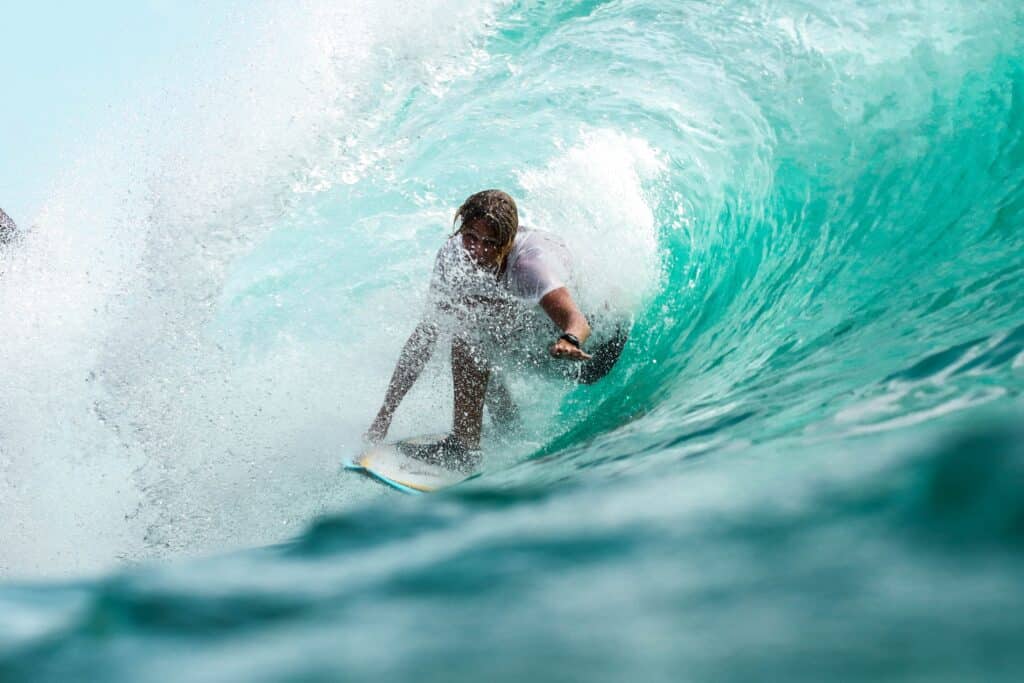
Taking close-up shots of surfers allows you to document their reactions and emotions as they navigate the water. You can also showcase how they interact with their equipment or gear while in motion.
For a more striking effect, use a fast shutter speed to cease movements mid-air during their dynamic turns on the wave.
2. Capture water movement and patterns
Capture the splashes, sprays, and patterns created in different directions when surfers ride inside the barrel of a wave and when they make quick maneuvers. This enables you to portray water bodies’ fluidity, power, and dynamism.
3. Aerial view of the body of water
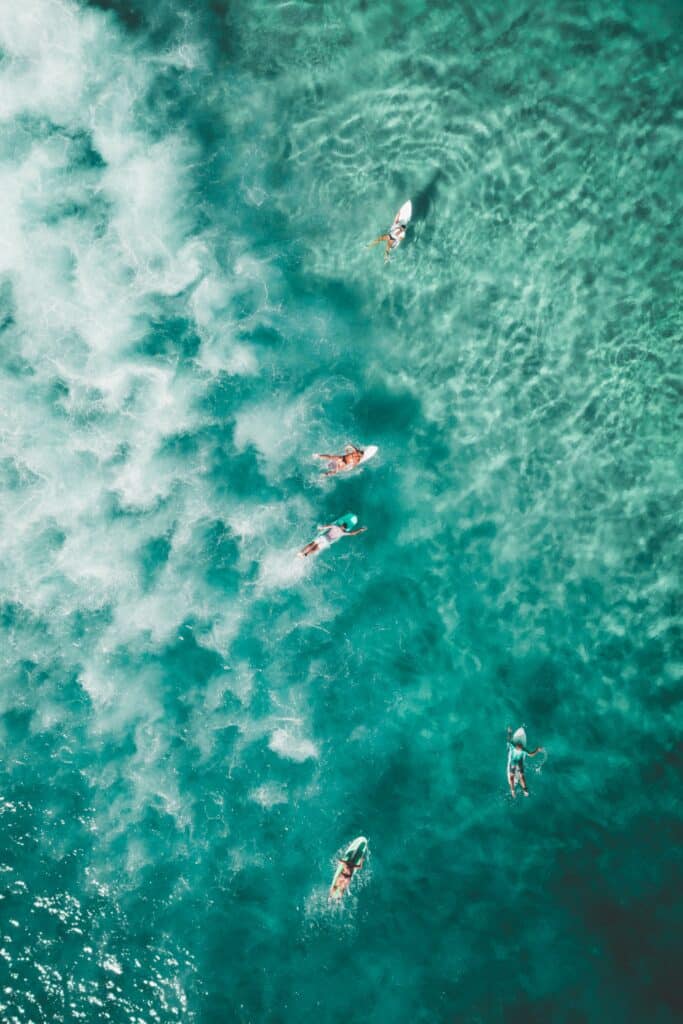
Unlike other wave pool photography ideas, you can’t actualize this one from ground level. So, you need a drone with high-quality cameras that will enable you to shoot from above, capturing the surrounding environment and displaying the wave pool, or body of water, at scale.
Moreover, taking wave shots from above is a unique way to showcase the beauty of nature and enthrall random viewers into loving wave pool surfing.
4. Outside the wave
Surfing is a lifestyle. Thus, taking shots of other activities outside the wave allows you to show wave pool surfing beyond the confines of water bodies and sports. You get to expand your story and drive more engagement.
Capture people relaxing, having a suntan, celebrating an event, playing another game, or cheering surfers. Document the emotions and expressions as much as you can.
5. The gear and tools
Capturing the surfing equipment, gear, and tools elevates your surfing photography beyond the usual narrative. It allows you to provide viewers with a better understanding of the sport and its intricacies.
You can capture the tools individually—highlighting their details—or collectively, arranging them aesthetically. This includes surfboards, wetsuits, fins, and leashes. Such shots also reveal the craftsmanship and innovation employed in surfing.
6. Before the storm
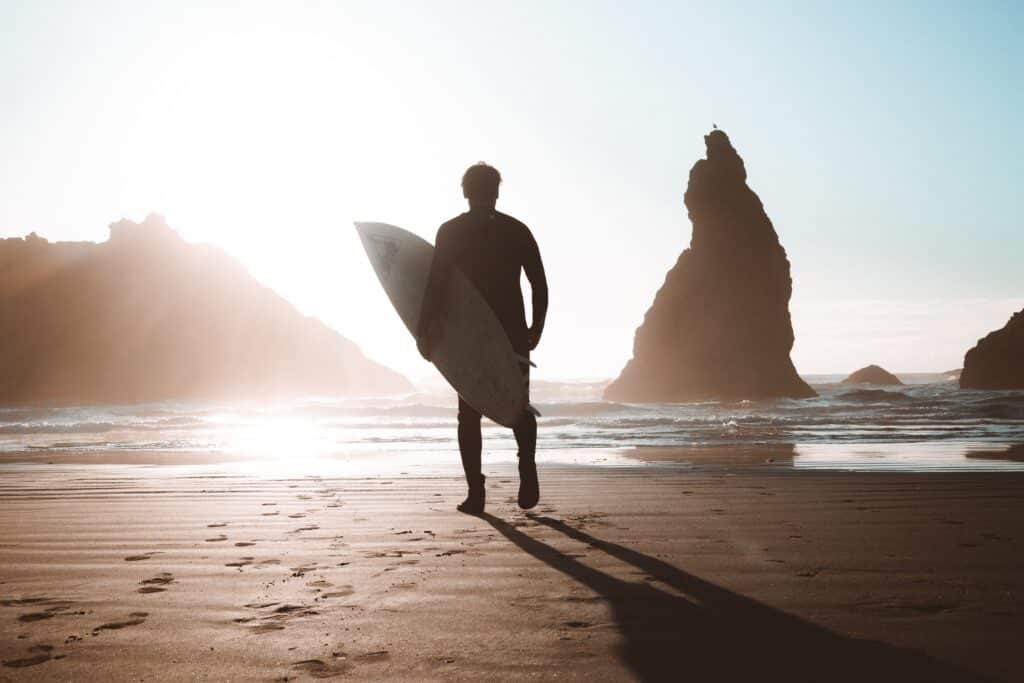
This idea involves capturing surfers getting ready to paddle out. You can photograph a surfer waxing their board, attaching a leash to their ankle, or interacting with their manager before entering the water.
In addition, if you’re at a wave pool, you can capture equipment managers preparing the wave pool, setting up wave-generating machines, and arranging gear racks for surfers. These shots explain the anticipation and process of preparing for wave pool surfing shows.
Strength competition photography ideas
Capture the intensity of strength competitions and showcase your photography prowess through these concepts below.
1. The great lift
Capture weightlifters or powerlifters as they hoist a heavy barbell over their heads or flip a tire in specific directions. Preferably, use a fast shutter speed to halt the action, displaying their strength, determination, and the intensity of the competition.
Remember to also shoot from different angles and perspectives for better context.
2. Power portraits
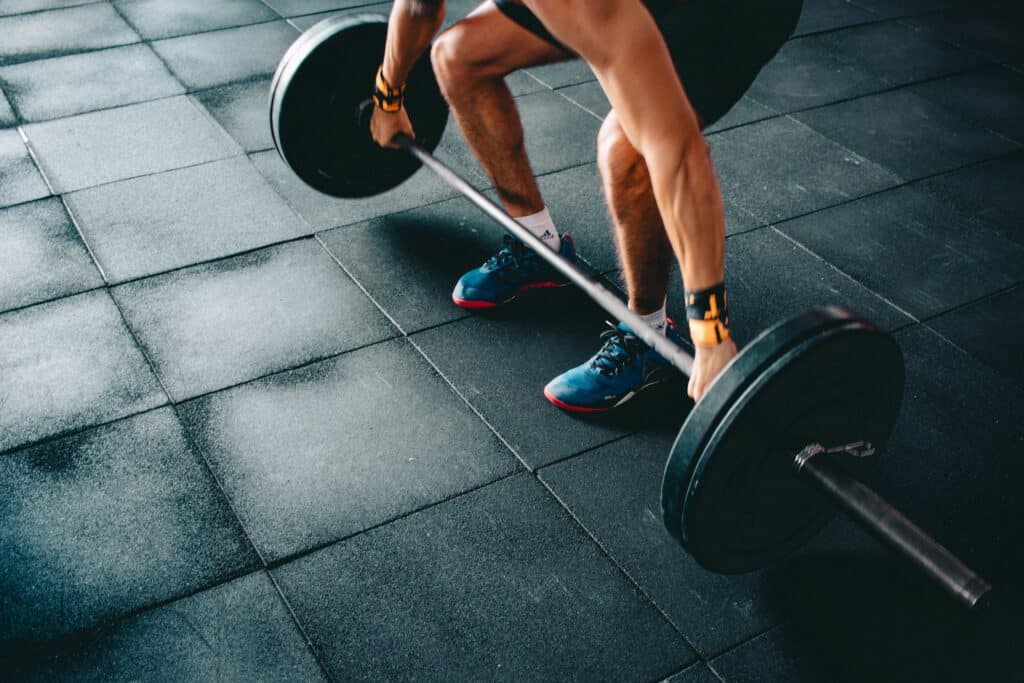
Take up-close shots of athletes in motion, highlighting their facial lines, calloused hands, muscles, biceps, quads, and the sweat on their faces. These shots enable you to showcase their resilience and zeal for strength sports.
You can use a shallow depth of field to blur the background and capture only necessary features. You can also capture moments when athletes celebrate their wins on the podium.
3. Before the lift
Focus on documenting athletes’ preparation processes before their lifts. Photograph them taking deep breaths, pacing, kitting up, or visualizing their success on the sidelines. Such images portray the eagerness and readiness of athletes before they step into the platform.
4. Audience reactions
Although strength competitions are strenuous, many euphoric moments remain to capture in the crowd. Look in the way of the audience at intervals and capture the diverse expressions on their faces.
It could be excitement, awe, displeasure, or indifference. Whatever the case, endeavor to take shots that properly explain the atmosphere of the competition to viewers.
The bottom line: Leveling up your sports photography game.
Watching a sports program or activity is enough to get your adrenaline pumping. However, being at the fore of the action, capturing fleeting moments—in sharp focus, of course—during an ongoing game is a more challenging adventure. Fortunately, with the above-mentioned ideas, you can walk into any sports event and make magic with your camera.
Moreover, as you implement these concepts, endeavor to showcase and protect your images effectively in your online portfolio website. Doing so enables you to establish your credibility and opens you to a world of opportunities in sports photography.

Build an online portfolio website you love.
Put your sports photography in the spotlight.